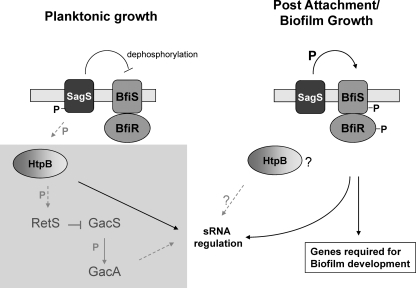Fig. 9.
Model for the role of SagS in linking the Gac/HptB/Rsm and BfiSR signaling systems prior to and following the motile-sessile switch. The proposed model of differential SagS activity prior to and following the motile-sessile switch integrates present findings (indicated by black arrows) and previously published data (gray arrows with dashed lines). Under planktonic conditions, SagS is phosphorylated and directly interferes with BfiSR activity, probably via dephosphorylation of BfiSR. Moreover, SagS modulates sRNA levels under planktonic conditions in an HptB-dependent manner. GacAS and HptB contribute to the regulation of the small regulatory RNAs (sRNAs) rsmY and rsmZ, which act through RsmA sequestration. RetS participates in a phosphotransfer with HptB and directly interferes with GacS activity (18, 22). Transition to the surface (postattachment and under biofilm growth conditions) coincides with SagS dephosphorylation, presumably via phosphoryl group transfer from SagS to BfiS, resulting in BfiSR activation (43), suppression of sRNA levels (in particular, rsmZ levels), and activation of genes and gene products required for biofilm development by P. aeruginosa (43, 44). While both SagS and HptB play a role in biofilm formation, SagS function appears to be independent of HptB (and GacA). The lightly shaded square area indicates components belonging to the Gac/HptB/Rsm signaling system (without indicating proper location in the cell). P, phosphoryl group or phosphoryl group transfer; ?, unknown contribution to biofilm formation or sRNA regulation under biofilm growth conditions; IM, inner membrane.

